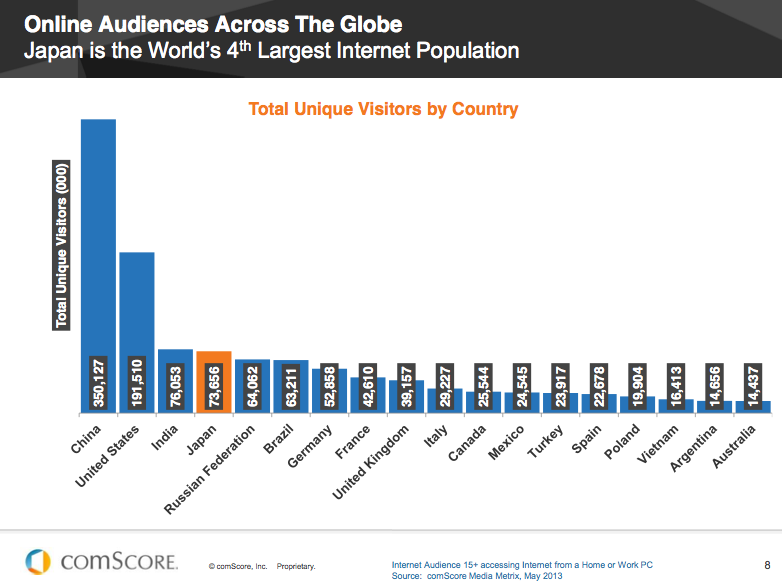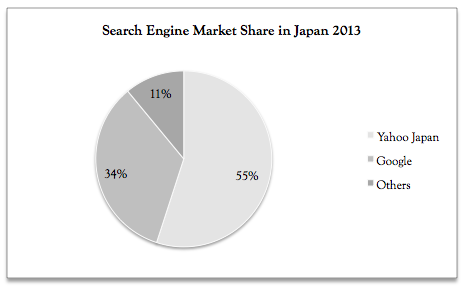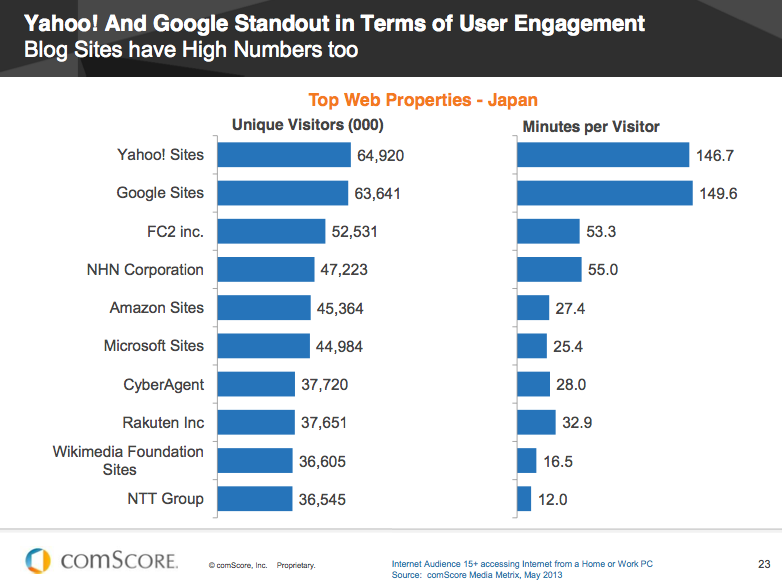Entering the Japanese Online Market – all you need to know!
Posted: Wednesday, March 05th, 2014 Posted by: Chirag DattaniJapan at a Glance:
A major contributor in electronics, industrial goods such as semiconductor, processed food, and locomotives; Japan has always been the epicenter of world’s technologically advanced countries. Where on one hand, it depends on technological innovations and pioneering breakthroughs, there on the other hand it still manages to be the most profitable agricultural country.
Japan is the world’s 3rd largest economy after US and China with GDP of 5.1 trillion and the 4th largest Internet population in the world after China, US and India.
Source: comScore Japan Digital Future in Focus 2013
Being the national language of Japan, Japanese is the not only the most spoken language but also equally well used in the Internet searches in Japan. There are however, different types of writing systems used in Japanese including Kanji, Hiragana, Katakana and Romaji. Users often write in combination of these languages, so appropriate keyword selection is extremely important. Japanese users are different and unlike in the West, they prefer websites to be ‘noisy’ or ‘busy’ while browsing the Internet. Mobile in Japan is considered to be the most developed market with smartphone penetration of 34.8% and Non-PC traffic in excess of 20%.² Hence, having a mobile site, mobile specific campaign and a mobile application is recommended along with Desktop and Tablet specific Marketing efforts.
As per a recent report from comScore, Japanese users that fall in 55 years and/ above age group, make up for more than double the global share, wherein the average male Internet usage exceeds significantly than female. Additionally, Japanese users of age group under 35 constitute 34% of total users.²
Localization v/s Standardization:
In the world of search marketing, we define localization as using local language, targeting local people and bidding on local keywords! While companies take a standardized approach as they enter into a new market and be uniform to minimize costs, localization is highly recommended to be successful which entails the need for adaptation, customizing strategy to fit the unique dimensions of each specific market. It’s no secret that one should have a unique strategy when entering into a new market, as the strategy that is used for marketing the products in their home country may not necessarily work in another country. Target Audience, Age Group of the Online Population, Languages Spoken, Cultural Habits, User Behavior etc. play a big role in making the program successful in any country. As they say ‘One size does not fit all’.
Search Engine Market Share in Japan:
Although Google Search dominates in most countries, Yahoo! Japan has a bigger presence in the Japanese market.
Importantly however, there are no recent official numbers/studies of the Japanese Search Market Share available in the market. Unofficial numbers are: 55% Yahoo Japan, 34% Google and others.
Search Engine Market Share in Japan
In the last few years, Google has been steadily growing its market share in Japan and according to comScore data in May ’13, Yahoo! Japan and Google had almost the same number of unique visitors in terms of user engagement.²
Source: comScore Japan Digital Future in Focus 2013
Naver (NHN Corporation) – the popular Search Engine from South Korea also had a small presence in Japan, which the company decided to terminate its services in December 2013. It will be interesting to see who gets the additional traffic in lieu of Naver.
Implementation Guide:
• Setup – Yahoo! Japan v/s Google: Although Yahoo! Japan uses Google technology to power its Search Engine, they are two separate platforms and one will have to set up and manage the account in their individual interface. Also, this does not mean that the results shown on both engines will be identical.
• Differences between the two engines: It is exciting to know that Yahoo! Japan interface is in English and identical with Google in terms of the format – Campaign, Ad Group and Keywords and same match types – Broad, Phrase and Exact which makes it easier to manage the account. There are definite challenges with the tool if one has only worked on Google AdWords previously. Yahoo! Japan recently launched its editor tool in January 2014, which is also in English and helps in making changes in Bulk.
• Time Zone and Currency: One should make sure to set up the account in the local time zone and the local currency. Due to differences in time zones, the best practice is to have the account in the local time zone – if one plans to go dark on weekends or for a holiday, then automated rules can be used in Google which uses the account time zone to make the changes. Additionally, paying the bills in local currency is advisable to avoid currency rate fluctuations on a daily basis.
• Popular Campaigns: Google’s new ad format – Dynamic Search Ads are becoming very popular in order to understand the kind of queries that users type in to search the products/Brand. Its similar to a 4th Match Type which Google uses and creates ads dynamically by matching the user query with the content on the page if one is not bidding on the exact term. This could also help in getting the appropriate traffic for some of the low funnel keywords for which creating its own campaigns and buying those keywords would be an unnecessary investment. Additionally, if one is considering using Google Display Network (GDN) then make sure to also check out Yahoo! Japan’s Display Network (YDN).
• Additional Character Limit: Google AdWords allows using more characters on the Title and Description for ads targeting Eastern European and Asian Countries, which helps in creating effective PPC ads as Japanese characters take more space for each character than English. One can use this by checking a small check box about character limits while creating an Ad Copy.
Some of the most common mistakes that companies make while entering the Japanese Online Market:
• Translation: Sole use of ‘Google translate’ or another translation software when entering into the Japan Market or any other international market. Meaning of keywords might change totally once translated with the fear of writing something offensive to the local audience. At the same time, merely translating English keywords into Japanese might miss the cultural factor. Using a translation service agency is recommended to have the cultural nuances figured out.
• Local Search Engines: Not advertising on Yahoo! Japan and just on Google. Although Google is really popular in US and most other countries, it does not have a similar market share in Japan and Japanese users have been using Yahoo! Japan more traditionally than Google. Leaving out the main Search Engine means targeting half the audience in Japan.
• Identical Strategy: Using the same strategy as used in the US market likely won’t work in any other market most of the times. It is advisable to use a localized approach and make sure to take each country at a time, study the local market and build a strategy accordingly.
• Traffic Estimates from Google: Using the Google Keyword Tool to forecast the traffic or spend estimates for keywords would only provide estimates for Google. Keep in mind that the same keyword sets may not have the similar range of traffic or CPC on Yahoo! Japan or any other Search Engine.
In conclusion, to be successful in the Japanese Online Market, it not only requires a great handle on linguistic research and translations but also, more importantly, entails a level of trust with consumers by understanding cultural nuances.
² http://www.comscore.com/Insights/Presentations_and_Whitepapers/2013/2013_Japan_Digital_Future_in_Focus













